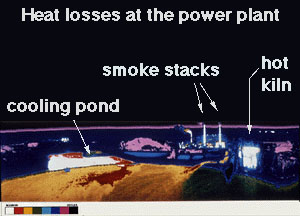ExploraTour - Looking at the World in a Different Light
This is a volcano on the island of Miyake in Japan. It has erupted, sending hot lava and ash into the air, a total of ten times. The time after one eruption until the next occurred was about twenty years in each case.
In 1983, black smoke came pouring out of Mt. Jinan and hot lava flowed down its side. The people on the island were very worried that Mt. Oyama, which is much larger, might also be preparing to erupt.
Remember that when an object is hot it gives off a special kind of light called infrared radiation. The infrared radiation, given off by the two mountains, was measured from space.
Engineers made a 3-D image of the mountain and laid the ground surface temperature map on top of it. This map indicates the temperature of a given region by its color. The legend that tells which temperature corresponds to each color is at the bottom of the image. For example, the pink areas are the hottest, the browns and yellows and greens are much cooler. You can clearly see the hot lava flows in pink. The people of the island were releaved to see that Mt. Oyama was cool. It was not going to erupt.
In this case, looking at the mountain in infrared was very important in deciding how to deal with a potentially dangerous situation and keep people safe.











